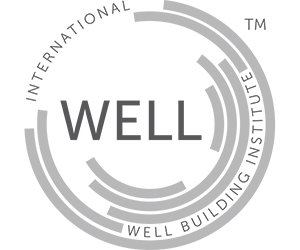The modern workforce spends significant time in their offices, and this can have less than profound effect on the human body. Designers and business owners are taking note, and programs dedicated to health and wellness have infiltrated many office perks. But there’s one more step designers are taking – optimizing entire buildings to constantly address issues of human health.
With a growing population of over 731 projects in 32 countries encompassing over 139 million square feet, the WELL Building Standard is reshaping how designers, property owners, businesses, and employees look evaluate health and wellness at work. The holistic approach to improving the human work experience through design is revolutionizing how businesses function, and how employees perceive and contribute at work.
In this post, we’ll outline the specifics of WELL certification, its guiding principles, and explore how it’s already benefiting businesses around the globe.
What is WELL?
The WELL Building Standard is the world’s first to focus exclusively on the health and wellness of the inhabitants of buildings. Released in 2014 by the WELL Building Institute, WELL represents a certification process based on measuring the performance and monitoring the features built-in to a building environment that have direct impacts on human health. This can mean the quality of air and water, access to natural light, fitness, comfort and ergonomics.
WELL emerged as a response in support of the 67% of working individuals under 65 who are affected by health issues related to food, physical activity, tobacco and stress, and is a combination of scientific and medical evidence-based research and industry best practices to tackle the utilization of buildings as vessels for health and wellness. The WELL certification dictates that owners and occupants can feel confident that their spaces are purpose-built to support human health through improving nutrition, fitness, work/life balance and happiness, sleeping patterns, and mood.
The WELL building standard was finely-tuned after seven years of research in conjunction with influential physicians, scientists, and industry building professionals and administered by a third-party affiliate of the Green Business Certification Inc (GBCI), the International WELL Building institute. Further to its own guidelines and mantra, WELL is designed to work flawlessly with the concepts of LEED, a globally recognized green building system. WELL is also certified through the GBCI, which also awards LEED certifications.
Benefits for Business?
The modern workforce spends up to 90% of their time indoors, says Regan Smith, managing principal of WSP Canada Inc. Health and wellness at work is a growing concern – and a number one trend – of the American Society of Interior Designers. Their 2015/2016 Outlook on the state of the industry notes commercial adoption of WELL practices still lags behind residential design adoption. Studies also show a 20% increase in shoppers feeling empowered to make positive buying decisions related to healthy eating.
But being a relatively new building standard means hard data is lacking, says Regan Smith, managing principal of WSP Canada Inc. While long term direct impacts are still largely being documented and collected, but the initial responses from pilot building occupants is overwhelmingly positive.
94% of WELL building occupants in Los Angeles’ CBRE office say the new space created a positive effect in business performance, while 92% agreed that the WELL space created a positive effect on their health. A staggering 90% of building occupants said they would not even consider going back to the old school way of working.
Randy Fiser, CEO of the American Society of Interior Designers, agrees, stating: “ WELL fosters a holistic approach for better health and wellness outcomes, leading to improvements in things like employee productivity, engagement, and retention.
The newly renovated TD Centre 25,000 square foot office space in downtown Toronto was recently awarded Gold level WELL certification, and is now the first property internationally to be certified under version 1 of WELL. The Canadian first renovation achieved this high level certification thanks to addressing all seven WELL categories:
- Air
- Water
- Light
- Nourishment
- Fitness
- Comfort
- Mind
Martha MacInnis, design director of Enterprise Real Estate, TD Bank Group, says that the WELL renovation of the office falls in line to the companies increasing dedication to making it a great place to work. “It made perfect sense to look at our existing design standards and figure out a way to elevate them to the next level.”
WELL Certification
There are three levels of WELL certification that employ preconditions; mandatory requirements that all project items need to meet. All certifications require a three-year re-certification cycle, with an exception for core and/or shell buildings.
- Silver – certification reaching 100% of WELL preconditions
 of all concepts.
of all concepts. - Gold – certification reaching 100% of WELL preconditions as well as 40% or more optimizations.
- Platinum – certification reaching 100% of WELL preconditions as well as 80% or more optimizations.
Three project yeps can apply for registration and certification under WELL: new and existing buildings, new and/or existing interior spaces, and compliance for a core and shell building. There are 41 mandatory requirements, with 40% optimization receiving gold, while 80% and upwards receives a Platinum certification.
It’s important to cite that while WELL and LEED building standards are meant to work in unison, LEED has a focus on quantities, while WELL relies on the quality of its awarded certifications. WELL is more focused on personal health and wellness of building occupants, while LEED is focused on how well buildings are operated with energy and energy performance in mind – something not specifically addressed within the guidelines of WELL.
—
Design is an integral aspect of building healthy and creative workplaces. The past approach of offering employees wellness programs and services dedicated to health meant providing it as an option, whereas integrating design to the WELL building standards puts the health and wellness of building occupants at the forefront of everyday discussion – ensuring that your company is a continual topic of attraction for new and emerging top millennial talent.
Establishing WELL practices into your businesses design creates an environment dedicated to exploring the physical, mental, and emotional comfort of our workplaces, while embracing the energy that contributes to happiness and health. Whether your business is ready to embrace WELL in its entirety, or in incremental stages, you can tap into the benefits of WELL by optimizing the workplace to help people perform, work, feel, and live the very best life possible.






